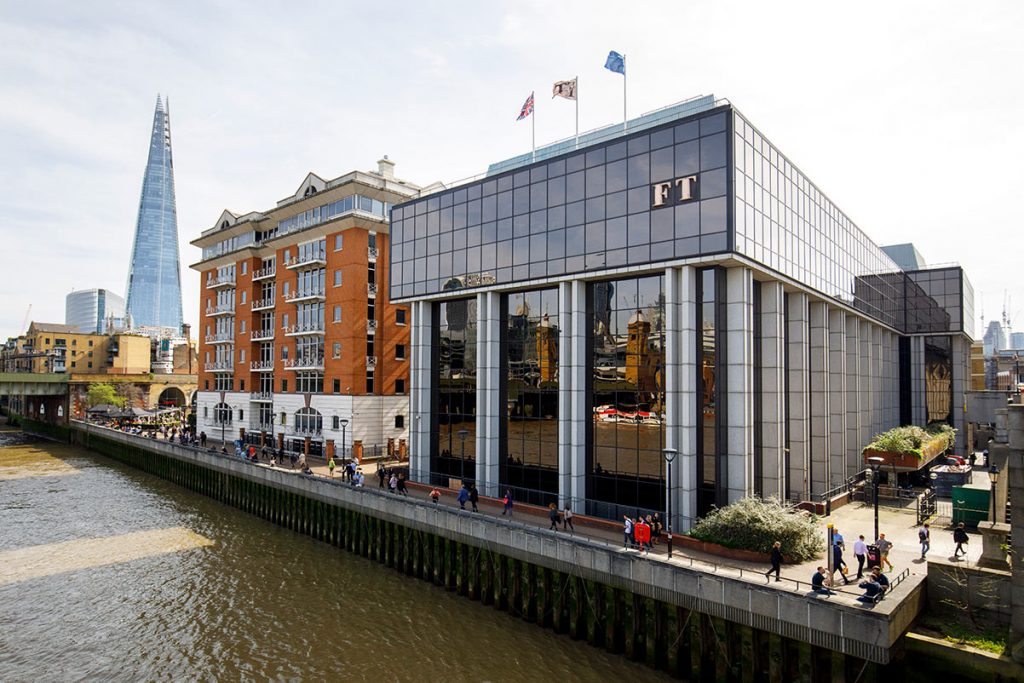HGS U3A’s Share Watch group was set up by our Chair, Jack Berkovi, with the aim of bringing together a group of like-minded members to investigate, select and track FTSE100 shares. After an initial meeting the group gradually became interested in around 30 shares and these have been added to a tracking spreadsheet. The group meets fortnightly and has been addressed by Neil Behrmann, a financial journalist, and also by stockbroker Brewin Dolphin who answered questions from the group.
On 12 July 2018, seven of the group visited the Financial Times (FT) at One Southwark Bridge where the Communications Team, had arranged a programme following contact with Jack. Our group met at reception and was taken to a Conference Room where we were to meet John Hughman, Editor, Investors Chronicle and, later, Malcolm Moore, Technology Editor, Financial Times.
How the FT has evolved
Oliver Stannard, Communications Manager, first told us about the FT and how it has been developing in recent years. The FT was one of the first papers with a subscription model. The FT used to be owned by Pearson and is now owned by Nikkei in Japan, who maintain an arms-length management relationship and share the FT’s goals to develop a more technology focussed vehicle. The FT is facing major changes. People associate it with the pink printed copy, and indeed it is their intention to continue to print a daily edition of the newspaper, promoting their brand by distributing the paper (and exclusively only the FT) at events. Sixty percent of their income comes from subscriptions, and hence there is a reduced reliance on advertising revenues. Their philosophy is that readers want good journalism and this has to be paid for. This approach is supported by their Japanese owners, Nikkei (who also run the stockmarket index in Japan and the NIkkei paper in Japan — the world’s largest financial newspaper, with a daily circulation exceeding three million) who purchased the FT around 3 years ago as a long-term, generally hands-off, investment and who encourage new technology, a transparent and communicative approach and, soon, the physical move for staff of their head office building near to St Pauls.

What’s more, 60% of total digital traffic comes from readers on mobile devices. The FT is often cited as a fashion icon in that it is seen carried and read by famous people like Sting and Benedict Cumberbatch. The FT brand is very powerful and is considered a leading journal in its field. The FT has more than 600 journalists working in 40 bureaux around the world.
Investors Chronicle
John Hughman explained the Investors Chronicle began 157 years ago and is the second oldest continuous publication (after The Spectator). It is owned by the FT and concentrates on UK and Irish Equities and recommends to investors how to build these into portfolios. It looks at the trends in specific sectors and companies, and well as examining major trends developing in the markets — such as increasing interest in cannabis for medicinal purposes or market shifts away from hydrocarbons. John explained the term “shuttlebutt” which means to examine first hand what is happening in the world around and builds a picture of major developments. He also explained the increased interest in behavioural economics and how this affects investment decisions and the importance of investors understanding their own motivations. For many it is the concern that the value of cash/money in the bank is nibbled away by inflation whilst the need continues to fund our long term needs through sensible investments.
In addition to the weekly press deadlines each Wednesday, they now also issue podcasts on company and personal finances as well as online updates in extra depth for professionals. He discussed the importance of not over-trading equities, of seeking diversity, with 10–12 shares in a portfolio covering the range of different markets, including not only geographical but also bonds, commodities and emerging markets. He suggested that around 5.5% growth above inflation was a reasonable goal, rather than seeking more spectacular but increasingly risky alternatives. We also discussed the competitors in the field like data servers and broker’s reports and the increasing role of PR/lobbyists necessitating a questioning, and sometimes cynical, approach.
The IC has a staff of around 30 based in London, and is primarily focused on UK markets but has expatriate readers globally. A large part of their overseas subscribers come from Ireland because of the dually-listed companies on the Irish and UK Stock Exchanges, in sectors like building and food. The IC is aimed at investors and its average reader age is around 60. The IC’s content comes from its journalists covering such features as “Why I’m building up my biotechnology exposure”, “Tips of the Year”, company news with share and fund news. It features regulated news like the Tesco/Carrefour deal and implications on markets. The IC develops selective broad investment themes and topics relevant to shareholders and has a sector focus, within which there are clusters of related groups; grocery retail and retail are linked, consumer products/services/gambling and travel are linked. The IC has developed a number of related services such as IC alpha — Alpha Asset Allocation Review looking at key investment issues and a weekly Podcast and tablet version that looks at factors affecting markets. Template portfolios are provided to assist new investors. Marketing Manager, Beth Clarke, joined us and we were all given a bag containing an edition of the IC, Alpha, a notebook, drinking cup, pen, and an exclusive subscription offer of a 20% discount for U3A members. The IC costs £4.90 per week, whereas the offer saves 66% on the cover price. Interested subscribers should follow this dedicated link or call 01858 438 808 quoting M87U3A20. It is interesting to note that the technology sector is not represented very significantly in the UK, with the recent departure of ARM Holdings going to a Japanese buyer, and just a few UK software companies remaining. The IC provides content to FT Money in the weekend edition of the FT.
John was asked what should U3A members do about investing and he explained the various options available which are covered by the IC. His guidance included investing for the longer term say 10–20 years, to “buy and hold” shares rather than dipping in and out with short term buying and selling. A shrewd investor can expect around 5.5% long-term return vs the current interest rate of around 0.5%. He suggest starting slowly, following no more than 10-12 companies, to “get rich slowly”. He suggested looking at trends, emerging markets around the world that could impact our economy.
John was asked to name some of the top tipsters to follow and he cited IC’s Algy Hall and Simon Thompson, Associate Editors, as two of the leaders in their field.
How the FT is adapting to future demands
Malcolm Moore explained the structure of the FT was changing from the current four main desks — UK, World, Markets, Companies — to now incorporate a 5th desk reflecting the increased impact of new technologies. He discussed his current role (Editor UK Desk) and future role (Editor New Technologies) and the need to understand the developments primarily in Asia and Silicone Valley and the interface between government and finance. He explained the impact of readers increasingly reading online, in understanding the limitations of scrolling on mobile phone platforms and the need for short articles incorporating chapters, bullet points and presentations very different from the ”inky fingered” printed version of the newspaper. Online news and the introduction of fastFT with its breaking news wire also provides fast and constantly updating information, whilst still promoting thoughtful and best quality articles. This brings its own challenges. The impact of this virtual “hamster’s wheel” with investors’ needing to feed immediately on the latest news must not be at the expense of carefully investigated journalism. In addition, despite an increased emphasis on brevity, articles still need to explain the complexities of the situations. Journalism in the future will undoubtedly face these issues. . One key move Malcolm is making is to have a regular global conference call link with key markets – he has found that midnight UK-time is the best time to get all countries together.
Malcolm showed us that the FT’s website is accessed by 75% of its readers and the digital revolution has meant a complete behavioural and attitudinal change for seasoned journalists. The immediacy and speed of access of mobile technology is having a massive impact of the journalist — whereas in the past “inky paper” allowed journalists plenty of time to get their story to press, the position has now changed dramatically. The digital or mobile first strategy adopted by the FT requires stories in and added to the website and mobile platforms rapidly, with further details added throughout the day. This results in greater in-depth coverage which is a key feature of the FT brand.
The FT operates a “call out” service where subscribers can contact journalists to add new insights to their stories. A microsite “Future of Europe” was launched last year as a new service especially aligned with Brexit and key questions for the Europe project. The FT also runs many events throughout the year and has a high level of audience engagement to keep the vibrancy it needs in a very competitive market.
Finally, Malcolm assured us that the FT doesn’t feature “fake” news and always follows a golden rule of having more than one source of material to validate stories.
A trip through the office
Oliver then took us through the area where we saw journalists and supporting teams covering graphics, marketing and reader contact. Then on to the FT’s sixth floor canteen where we had a very enjoyable lunch with Oliver. A few hours well spent.
Report by Carmel Eilon and Jack Berkovi
Post visit comments from members of HGS U3A ShareWatch:
- Hi Jack – it was a brilliant tour on Thursday 12 July 2018. Thank you very much for arranging it. And thanks too to Oliver Stannard, John Hughman, Beth Clarke and Malcolm Moore for hosting us so well and for their interesting and thought provoking talks — and not forgetting the FT Editor who made the whole visit possible!
- The walking tour around the newsroom and lunch in the canteen were a wonderful end to a really interesting day. Thank you very much indeed.

